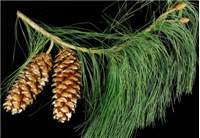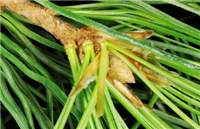Name
Pinus strobus L. var. chiapensis Martínez, Anales Inst. Biol. Univ. Nac. Mexico 11: 81 (1940).
Description
Habit: Small to large tree up to over 60 m in its natural habitat. Trunk usually straight and tapering, crown conic, broadening with age, becoming irregularly round-topped, sometimes developing heavy branches. Branch ends often erect with foliage in dense masses.
Bark: On young trees thin and smooth, greyish green to grey-brown, becoming darker and thicker with age and irregularly fissured and ridged into long, rectangular plates.
Foliage: Needles in 5s, 6-14 cm long, 0.6-0.8 mm wide, bluish green, lines of stomata on inner side, very slender, soft and flexible, may be slightly twisted, tending to droop.
Branchlets: Slender, greenish at first, becoming brown, ribbed, more or less covered with short hairs at first, later usually without hairs except for a patch below the base of the needles.
Winter buds: Small, c. 5 mm long, ovoid-cylindric, pointed, resinous, greenish, scales pointed, tightly pressed but some free at tips.
Cones: Solitary or clustered, pendulous, with long recurved stalks 2-3 cm, narrowly cylindric, often curved, tapering towards the tip, 6-25 cm long, 4-8 cm wide when open, light red-brown, very resinous, maturing in 2 years, shedding seeds and falling soon after. Cone scales thin, flexible, exposed end rounded, umbo smooth, pointing forward except near base. Basal scales usually not reflexed.
Seeds: Small, 7-9 mm long, tapered at both ends, brown with a narrow pale brown wing c. 15-25 mm long.
Notes
Only insignificant morphological differences exist between P. strobus var. chiapensis and P. strobus. The former probably best diagnosed by the longer seeds (7-9 mm) and the non-reflexed basal scales on the cones as opposed to the 5-6 mm long seeds and the reflexed basal scales of the latter.
Natural Distribution
Mexico, Guatemala.

